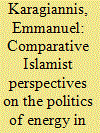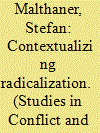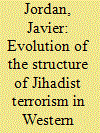| Srl | Item |
| 1 |
ID:
133505


|
|
|
|
|
| Publication |
2014.
|
| Summary/Abstract |
The article will describe the general Islamic approach on energy based on the Sunnah of Prophet Muhammad, as well as the writings of prominent Muslim thinkers. Then it will examine and compare the energy perspectives of four Islamist groups: Hizballah, Hizb ut-Tahrir, the Muslim Brotherhood, and Al Qaeda. It will be argued that Islamist groups have attempted to achieve their external energy objectives by either using violence or exercising political blackmail against their opponents. Moreover, Islamists have developed globalized, glocalized, or localized "scale of engagement," depending on the targeted audience. Finally, the article will examine the security implications stemming from Islamists' interest in energy issues.
|
|
|
|
|
|
|
|
|
|
|
|
|
|
|
|
| 2 |
ID:
133506


|
|
|
|
|
| Publication |
2014.
|
| Summary/Abstract |
This article proposes an analytical perspective on jihadist radicalization that focuses on the immediate social environment from which clandestine violent groups emerge, to which they remain socially and symbolically connected, and from which they receive some degree of support. Based on a detailed analysis of the "Sauerland-Group" it traces relational dynamics shaping individual pathways as well as processes of group formation within local Salafist milieus, the wider Salafist movement, and radical jihadist networks. It argues that one characteristic feature of "homegrown" jihadist groups is their simultaneous connection to and embeddedness in various different social contexts as well as the fluid, ad-hoc character of the clandestine group and its ambivalent relation with its supportive social environment
|
|
|
|
|
|
|
|
|
|
|
|
|
|
|
|
| 3 |
ID:
133508


|
|
|
|
|
| Publication |
2014.
|
| Summary/Abstract |
The study examines the effect of female suicide attacks on foreign media framing of conflicts. Examining the Palestinian-Israeli conflict, 2,731 articles were sampled that covered terrorist events (American, British, and Indian press); 625 appeared in the week following a female's suicide attack, 97 reported an attack by a female perpetrator. The findings suggest that foreign media discourse around female suicide bombers promotes more messages about the society within which the terrorists are embedded. Since the coverage of female terrorists tends to provide more detailed information about the perpetrator, it focuses more on the terror organizations' side of the conflict's story.
|
|
|
|
|
|
|
|
|
|
|
|
|
|
|
|
| 4 |
ID:
133507


|
|
|
|
|
| Publication |
2014.
|
| Summary/Abstract |
This article studies the structure of jihadist terrorism in the West from the perspective of the existence or absence of links between grassroots militants and organizations such as Al Qaeda Central and its regional affiliates. It undertakes a comprehensive case study of jihadist militancy in a European country (Spain) over a period of almost two decades, from 1995 until December 2013. The study analyzes the results of 64 antiterrorist operations carried out during this time.
|
|
|
|
|
|
|
|
|
|
|
|
|
|
|
|
| 5 |
ID:
133509


|
|
|
|
|
| Publication |
2014.
|
| Summary/Abstract |
This article seeks to determine the mechanism(s) behind the convergence of domestic counterterrorism regulations that has been noted across many Organisation for Economic Co-operation and Development (OECD) countries. Four hypotheses are developed and tested through regression analyses. These hypotheses examine (1) U.S. influence, operationalized though a unique U.S. footprint indicator; (2) national characteristics; (3) the extent to which states' domestic structures match; and (4) international networks. We find little support that U.S. influence matters. The international influence that does exist seems to operate through networks promoting learning, especially following a rise in the general global threat level. National characteristics as a driver also find some support.
|
|
|
|
|
|
|
|
|
|
|
|
|
|
|
|